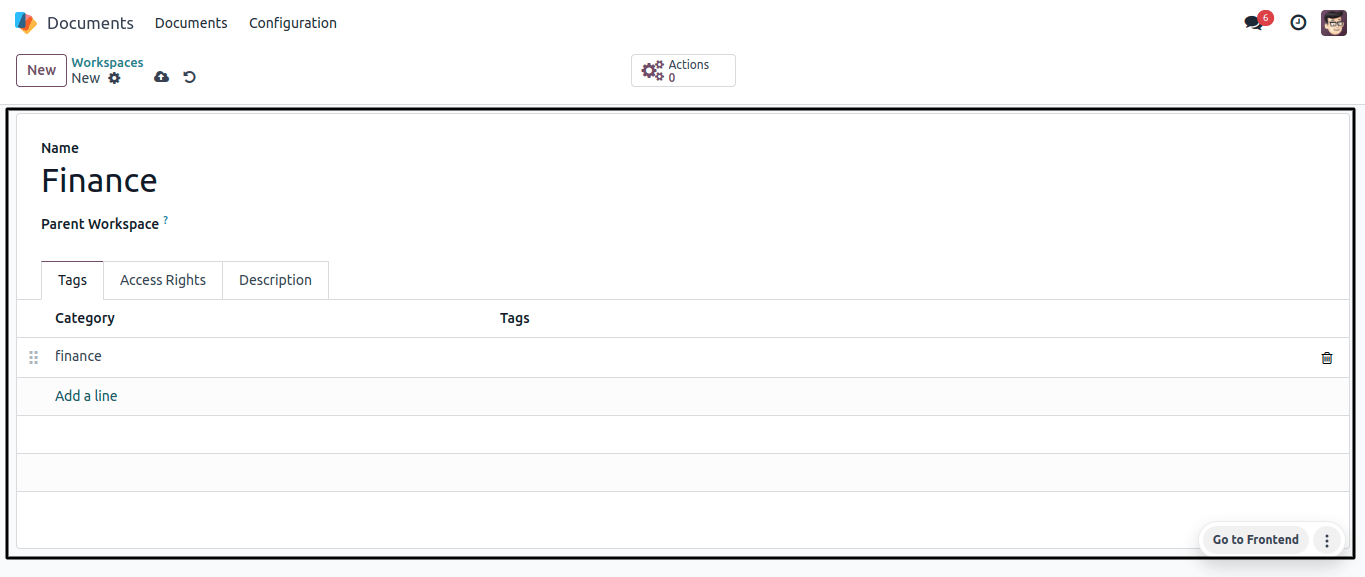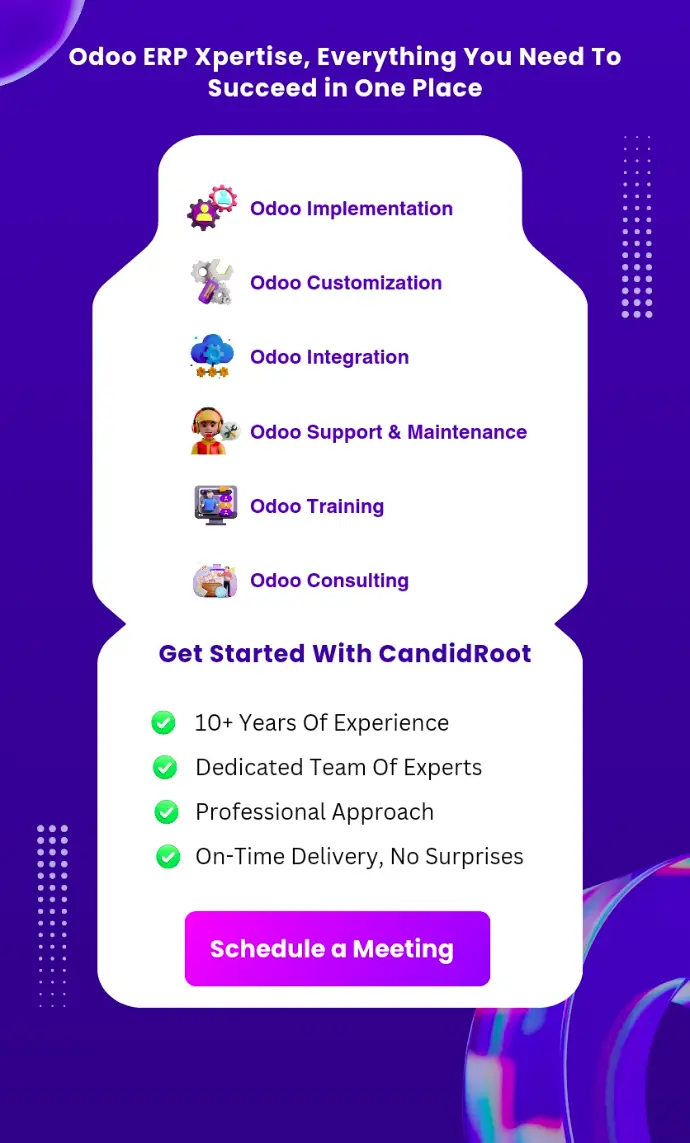Document management solutions minimize paper storage, improve retrieval, and increase regulatory compliance. They enable effective electronic delivery, lowering costs and delays. They also provide customizable retrieval and indexing, better search functionality, and controlled document delivery.
They also offer disaster recovery via fail-safe archives and backup solutions. Document management software helps with regulatory compliance by integrating security controls, audit trails, archiving, and disaster recovery.
The Odoo document module provides a safe solution for corporate document management. To prevent data loss, it uses encryption, two-factor authentication, tracking, and logging.
Integration with other modules increases organizational efficiency and collaboration. Document management systems are used to manage private papers and organize company operations.
The Odoo Documents Module is a user-friendly and compact platform that includes a document section for each document submitted. It is a significant tool for document management in an organization since it consists of several useful features that can manage all aspects of document processing in a business.

Documents menu
Inside the Documents menu, the left-side sorting column displays several document categories, such as ‘WORKSPACE,’ ‘TAGS,’ and ‘ATTACHED TO,’ allowing for quick sorting based on specified criteria.

Advanced Search Bar:The ‘Filters’ option allows users to filter documents and save frequently used ones to the ‘Favorites’ category within the advanced search box.
The upper left side of the page contains options such as ‘Request,’ ‘Add a link,’ ‘Share,’ and ‘New Spreadsheet’ within the dropdown section offered by the ‘Upload’ button. We can create new spreadsheets, request documents, add links, and share them.

Kanban View organizes every document template. The Kanban view lets you quickly access information such as the Document Name, the related Signature Template, linked tags, the creation date, and other details. As shown below, clicking on any document template will reveal a toolbox with a comprehensive preview.

You can do several functions on the documents, including downloading, sharing, replacing, locking, opening chat, and deleting them, using the icons provided on the right side of the page, as seen in the image above.
We may also do different activities, such as creating a task, marketing it as a draft, creating an expense, and depreciation, by clicking the corresponding buttons under the activities button.
Upload Button
To upload a new document, simply click the ‘Upload’ button in the top left corner of the document window. This will open your device’s document storage What Are the Steps to Manage Documents Effectively in Odoo 17?box, allowing us to select and import the right documents into your Odoo Documents database from storage.
Action Menu
The action menu near the Upload button includes Knowledge, Dashboards, and Spreadsheets options. The knowledge button allows us to create instructive articles from various documents using the Odoo knowledge module.
The Dashboard button allows us to add a specific document to the Dashboard pane of the Documents menu. The Spreadsheet button can also link the menu and document contents to a spreadsheet.
Configuration Menu
The second and last menu in the Odoo 17 Documents Module is ‘Configuration’. The menu options include ‘Settings,’ ‘Workspaces,’ ‘Tags,’ ‘Actions,’ ‘Shares & Emails,’ ‘Activity Types,’ ‘Activity Plans,’ and ‘Spreadsheet Templates,’ as shown in the image below.

Settings
The ‘Settings’ window in the Document module enables important setting options on the ‘Files Centralization’ tab.

This section provides access to several important configuration settings, particularly those under the ‘Files Centralizations' tab. The ‘File Centralization’ page is intended to help you streamline and organize your documents effectively.
We can set the deletion delay for papers in the trash under the Deletion Delay section. Then we may focus on the important files and create workspaces for Spreadsheets, sign, approvals, and Fleet-based documents within the Fleet section. This component offers centralized workspace management for several types of documents.
1. Human Resources: The ‘Files Centralization’ menu includes a ‘Human Resources’ option. Activating this option allows you to centralize employee-related documents such as contracts, payslips, and other important documents.
- Workspace: Designate a specific workspace for storing all human resources papers.
- Payroll Workspace: Create a separate workspace for payroll-related documents to keep them organized and easily accessible.
- Default Tags: Use the default tags to group documents together for easier management and retrieval.
- Payslip Contracts: Specify specific contracts about pay stubs for new businesses.
- Product:The ‘Product’ option organizes product-related documents such as spreadsheets into a tab.
The module allows users to choose a workspace from a pre-configured list, either an existing one or a new one, ensuring that all product documentation is centralized in one location.
This feature can be accessed via a drop-down menu or by clicking on the external link icon.
2. Recruitment: The ‘Recruitment’ option in the ‘Files Centralization’ tab streamlines the management of recruitment-related documents by centralizing files linked to job applications and postings.
Enabling this option guarantees that all recruitment files are integrated and arranged within a specific workspace, providing document management.
3. Accounting: Enable the ‘Accounting’ option in the configuration settings to centralize accounting records and documents. This will make it easier to keep and access financial information by consolidating all records and documents into one field.
Workspaces
The ‘Workspaces’ option in the Odoo Document module allows the creation and updating of workplaces, which can be accessible via the ‘Workspaces’ menu products.
This window shows the dashboard for existing workspaces, sorted by Workspace name, Tag Categories, Company, Write Groups, and Read Groups, as shown below.

Click the ‘New’ button to create new workspace information. As seen below, we can configure the Parent Workspace, Access Rights, and Description information.

Tags
The "Tags" option menu allows us to define alternative tags for documents, workspaces, and so on. After selecting the "Tags" menu option, you will be sent to a screen that displays a list of tags arranged by "Workspaces," "Category," and "Tags," as seen below.

The settings interface includes a complete list of pre-existing Tags to help you organize and categorize documents efficiently.
Users can view these tags, add them as favorites, sort and filter them using filters and group by options, and create new Tags by clicking the ‘New’ button.
The ‘Favorites’ field allows users to quickly access and apply their most important tags without going through the whole list.
The ‘Filter’ and ‘Group By’ options allow users to filter down the list of tags based on certain criteria and organize them according to selected attributes. Adding additional Tags is also available using the additional configuration form.

Actions
Odoo 17 Documents simplifies document management and business processes by automating workflow activities across all workspaces and offering one-click document generation, invoice processing, signature, file, categorization, tag addition, and file transfer.
The ‘Action’ portion of the ‘Configuration’ menu allows you to set up several actions by showing a dashboard with various ‘Workflow Actions.’

The workflow actions are arranged in the ‘Activity’ section according to their ‘Related Workspace,’ ‘Action Button Name,’ and ‘Created on’ dates.
The ‘Export All’ option allows users to download the whole contents of an Excel file. You can build a new, personalized workflow activity using the New Workflow Actions Configuration form.

Fill up the Workflow Actions Configurations form with the required information, such as the Action Name, Conditions, Tags, Actions, and other Miscellaneous elements shown in the image above.
Shares & Emails
To display the ‘Share Links’ window, go to the ‘Share & Emails’ options on the ‘Configuration’ page of the Odoo Document module. This function allows you to easily manage and check all shared links, as shown in the figure below.

The window provides shared document URLs and emails, as well as a dashboard preview that includes Workspace, Name, Share Type, Allows to, Created by, Created on, and Status.
To display specifics, clickWhat Are the Steps to Manage Documents Effectively in Odoo 17? on the proper data field. To download the link details, click the ‘Export All’ icon in the action button’s top left corner.
After selecting the proper workspace entry, we may export individual entries using the Export button, as seen below.

Activity Types
Activity Types in Odoo 17 simplify processes and workflows by categorizing and standardizing them, allowing for easy tracking of repetitive tasks, and giving customizable features for greater efficiency.
The activity kinds dashboard displays a list of activity kinds including name, default summary, planned In, and type, as shown below.

Create a new Activity Type with the new configuration form, filling out the Activity Name, Activity Settings, and Next Activity details as shown below.

Activity Plans
Odoo’s Activity Plans improve company operations by ensuring that particular actions are completed in a specific order, resulting in consistency and efficiency in repetitive tasks such as sales follow-ups and customer on-boarding.
We may see a list of different activity plan names, step counts, and department specifics below.

We can rapidly build a new Activity Plan based on the business requirements by clicking the New button and entering the necessary information such as Plan Name, and Activities To Generate, as shown below.

Spreadsheet Templates
Spreadsheet Templates, a combination of spreadsheet tools and powerful data capabilities, allow users to design, customize, and automate data-driven documents.
You can personalize these templates in the Documents Module by selecting the Spreadsheet Templates feature from the configuration menu, as shown below.

The ‘Spreadsheet Templates’ list view in Odoo 17 Documents provides each template’s name, created by, created on, and spreadsheet file data.
To download the spreadsheet file, click the download icon in the spreadsheet file column. To add a new spreadsheet to a certain template, use the ‘+New spreadsheet’ option.
Existing reports can be simply modified by selecting the ‘Edit’ option. Furthermore, the ‘Make a copy’ link in the columns lets you clone a spreadsheet template for future use.
This blog describes Odoo 17’s Documents Module, which provides a digital solution for efficient and simplified document management.
Its goal is to reduce the need for document records while optimizing company processes by managing sensitive information and guaranteeing safe document management.



